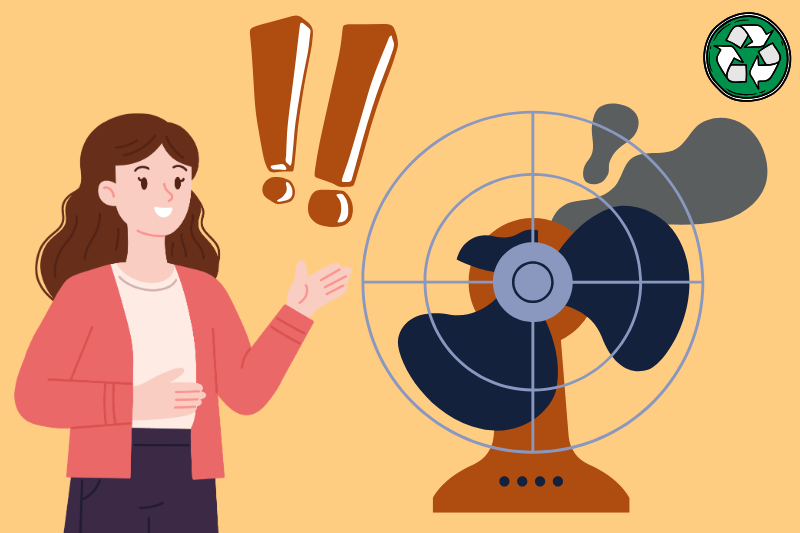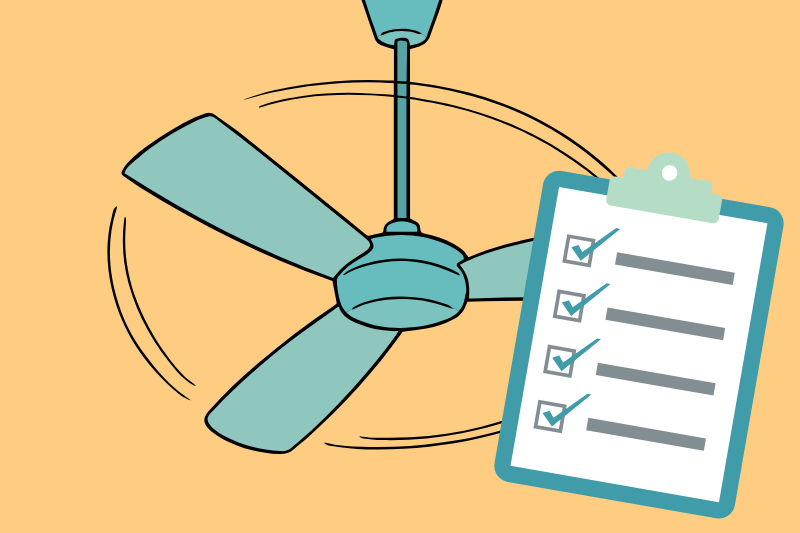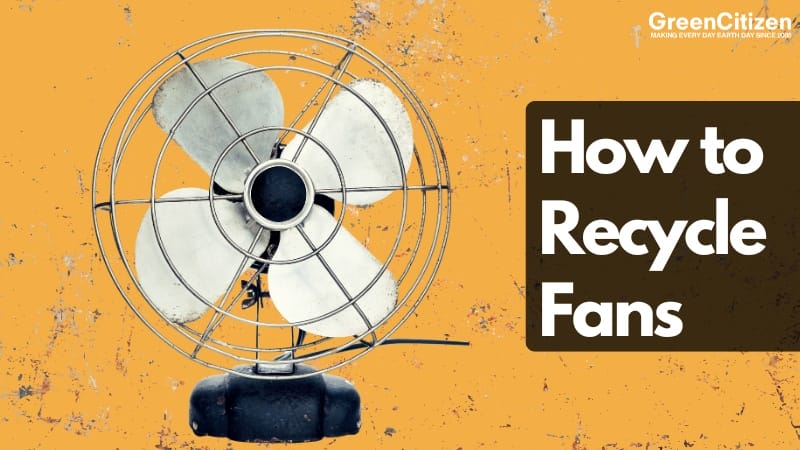If you’ve ever asked how to recycle fans, you’re not alone. Old box fans, broken ceiling fans, even standing fans tend to sit in garages because no one’s quite sure what to do with them.
But fans aren’t regular trash. They’re e-waste — inside that plastic housing is a motor, copper wiring, a circuit board, and sometimes even a capacitor — all components that can leach toxic metals if improperly disposed of.
Tossing fans in your household trash or recycling bin isn’t just environmentally harmful — in many places, it’s legally restricted. Cities across the U.S. require fans and small appliances to be processed by certified e-waste recyclers.
This guide breaks down how to dispose of fans the responsible way. Whether yours is working, broken, or missing blades, you’ll find out what parts are recyclable, where to recycle fans near you, and what options you have beyond the bin.
Key Takeaways: How to Recycle Fans Properly
You can’t recycle fans in your curbside bin. Old or broken fans should be taken to certified e-waste recyclers, municipal drop-off programs, retailer drop-offs, and manufacturer take-backs. Working fans can often be donated or resold. Prepare your fan properly before drop-off to ensure it’s recycled responsibly and kept out of the landfill.
Can You Recycle Fans?
Yes, fans are recyclable — but not through your curbside recycling bin. Most household fans, including box fans, standing fans, and ceiling fans, are considered small appliances or e-waste. So, you need a certified e-waste recycler to recycle ceiling fans legally.
Each type of fan has different recyclable parts:
- Box Fans: These typically include a plastic body, electric motor, and metal grilles. Most of these components can be separated and recycled by e-waste processors.
- Standing Fans: Also known as pedestal or oscillating fans, they contain similar recyclable materials plus additional plastic or metal from the adjustable stand.
- Ceiling Fans: These are heavier-duty appliances that contain large motors, blades made of wood, plastic, or metal, and sometimes integrated lights. These parts are all recoverable — especially the copper coils, motor casings, and metal hardware.
However, you cannot place fans in regular blue recycling bins. Their mixed materials and electrical parts make them incompatible with standard municipal recycling systems.
Instead, take them to an e-waste recycling center, hardware store collection point, or schedule a local appliance pickup service. These facilities are equipped to dismantle and sort the materials safely and efficiently.
Where to Recycle Fans Near You (Best Local and National Options)
Fans cannot be recycled through regular curbside bins — but they are accepted at certified appliance recycling facilities, municipal e-waste programs, select retail stores, and occasionally by manufacturers. These options vary depending on your location and the type of fan you’re disposing of (box, standing, or ceiling).

Below are the four best ways to recycle fans near you, with tips to help you choose the right method and prepare your fan for drop-off.
1. Certified E-Waste Recyclers (Best for All Fan Types)
Certified e-waste facilities can recycle all types of fans. These facilities are equipped to safely dismantle the motor, extract valuable metals like copper, and recycle plastics or steel. So, not only are you stopping hazardous materials from polluting the environment, but you’re also helping manufacturers with reclaimable resources.
- Fan types accepted: All fan types, including broken or dismantled units
- Availability: Widespread in cities and through business pickup programs
- Fees: Usually free or low-cost; may charge for large fans
- Best for: People with multiple fans, damaged units, or needing a traceable process
Pro tip: Look for R2 or e-Stewards certification. In the San Francisco Bay Area, GreenCitizen accepts fans (at $1/lbs.) and provides downstream accountability.
2. Municipal Recycling Programs (Great for Residents)
Local governments often accept fans at special e-waste events or permanent drop-off centers. Some cities offer curbside bulky item pickups that include small appliances.
- Fan types accepted: Box and standing fans (varies by city); ceiling fans less commonly
- Availability: City transfer stations, public works departments, annual e-waste events
- Fees: Usually free for residents
- Best for: Households without access to private recyclers
Pro tip: Always check your city’s waste authority website first. Not all programs accept electronics without screens — so confirm fan eligibility before loading up your car.
3. Manufacturer Take-Back Programs (Best for Newer or Smart Fans)
Some brands offer take-back programs with mail-in recycling, store trade-ins, or even upgrade rebates — especially for connected or premium fans.
- Fan types accepted: Smart fans, premium air circulators, certain brand-specific models
- Availability: Dyson, Hunter, Vornado, and others (varies)
- Fees: Usually free; sometimes includes shipping
- Best for: Owners of high-end or branded fans, or buyers upgrading to a new model
Pro tip: Check your manufacturer’s site under “Sustainability” or “Support.” If unavailable, your state’s Extended Producer Responsibility (EPR) law might still offer options.
4. Retail Drop-Off at Big Box Stores (Convenient but Limited)
Stores like Best Buy and Lowe’s have small appliance recycling programs that accept fans — but with limitations based on fan size and condition.
- Fan types accepted: Mostly box and standing fans
- Availability: Nationwide at select locations
- Fees: Free, but limited by store policy and item condition
- Best for: One-off fan disposal when shopping for a replacement
Pro tip: If you’re buying a new fan, ask about haul-away services. Some retailers will remove your old unit at no extra cost when delivering a new one.
Still not sure which option works for you?
Use the Green Directory by GreenCitizen to find certified local fan recyclers near your ZIP code.
How to Prepare Your Fan for Recycling (Step-by-Step Checklist)
Before recycling your fan, it’s important to prepare it correctly — especially if you’re dropping it off at a certified e-waste recycler, retailer, or local waste facility. Improperly prepped fans may be rejected or improperly processed.

Here’s how to get your fan ready for responsible recycling:
1. Unplug and Test the Fan (If It’s Still Functional)
If the fan still works, consider donating it instead — many charities or reuse stores accept working fans. For recycling, it’s still helpful to test the fan briefly so you can label it as working or non-working, which may affect how it’s processed.
2. Remove Any Batteries or Smart Modules
Some modern fans include removable batteries or smart features with internal memory or Bluetooth/WiFi. These components must be removed and recycled separately, as they contain hazardous materials not accepted in general appliance recycling.
3. Keep the Fan Mostly Intact
Unless instructed otherwise by a recycler, don’t dismantle the fan completely. Most facilities prefer to receive the full unit so their technicians can safely separate materials.
However, you should:
- Remove dust and debris (especially from grills and blades)
- Detach removable base stands (for standing fans)
- Bundle or tape the cord securely to prevent tangling
4. Special Caution: Ceiling Fans
Ceiling fans often include:
- Large capacitors that store electric charge
- Integrated light kits with bulbs or ballasts
- Multiple materials (metal, wood, plastic)
If possible:
- Remove light bulbs and glass domes
- Check whether your recycler prefers these components separated
- Handle capacitors carefully — they may retain a charge
5. Label the Unit (If Required)
Some drop-off programs require you to:
- Label the fan as “Working” or “Not Working”
- Attach a tag with your name, ZIP code, or appointment number
- Drop it off in a specific appliance recycling bin
Always check your recycler or city website for program-specific rules.
Pro Tip: If you’re unsure about any part of the prep process, call your recycler or retail location ahead of time. Proper preparation increases the chance your fan will be recycled — not landfilled.
Where to Donate Working Fans (Best Places to Give Them a Second Life)
If your fan is still in good working condition, donation is one of the most eco-friendly ways to keep it out of landfills. Many organizations accept gently used box fans, standing fans, and even some ceiling fans — especially during warm months or heatwaves.
Here are the best places to donate a working fan:
1. Habitat for Humanity ReStores
What they accept: Box fans, standing fans, and ceiling fans in working order.
Why donate here: ReStores resell donated appliances to support affordable housing projects. They often accept light home appliances and building fixtures.
Ceiling fans must have all blades and parts intact. Some ReStores offer pickup for larger donations — call ahead to check.
2. Local Shelters and Cooling Centers
What they accept: Primarily box and standing fans.
Why donate here: Homeless shelters, senior centers, and emergency cooling centers often need fans during heatwaves or summer months to protect vulnerable populations.
These facilities prefer plug-and-play fans that don’t require installation. Always call to ask what they need — some even post donation requests on community boards or social media.
3. Nonprofit Thrift Stores (e.g., Goodwill, Salvation Army)
What they accept: Working box and standing fans in clean condition. Ceiling fans are rarely accepted due to wiring and installation complexity.
Why donate here: Your old fan helps fund job training and community outreach efforts.
Make sure your fan is fully functional, clean, and includes all detachable parts. Items that don’t sell are often discarded, so quality matters.
4. Local Buy Nothing Groups or Facebook Marketplace (Free Listings)
What they accept: Any working fan — condition just needs to be honest.
Why donate here: These platforms connect people in your neighborhood who may need a fan but can’t afford to buy one. It’s fast, direct, and keeps the item in use.
Add “still works” and a quick condition note in your post. You’ll often find a taker in less than 24 hours.
5. Schools, Churches, and Community Centers
What they accept: Mostly box and standing fans for classrooms, offices, or events.
Why donate here: These spaces often need fans for seasonal events, temporary cooling, or backup equipment.
Drop them a call or email first — many centers have specific donation drop-off hours or wishlists.
Pro Tip: Label your fan as “Working,” wipe off visible dust, and tape the cord neatly. A clean, well-presented item is more likely to be accepted and reused.
Can You Sell Old Fans for Money? (Where & When It’s Worth It)
Yes, you can sell old fans for money — but only if they’re clean, functional, and in demand. Most resale opportunities are limited to working box fans, standing fans, or vintage ceiling fans with aesthetic or brand value. Broken or heavily used units rarely sell.
1. Online Marketplaces
- Facebook Marketplace and Craigslist are your best bets for local pickup.
- OfferUp and Nextdoor also work for neighborhood-level listings.
- Mention the brand, model, condition, and reason for selling.
Pro Tip: Post during hot seasons — fans move quickly when people are scrambling to cool off.
2. Vintage or Designer Ceiling Fans
Some old ceiling fans (e.g., Hunter, Casablanca, Emerson) are collectible if:
- They have wooden blades or antique finishes
- The motor still runs quietly
- Replacement parts are rare or discontinued
Check eBay for price comparisons before listing yours.
3. Bundle With Other Appliances
If you’re downsizing or moving, bundle your fan with small kitchen or household items in a garage sale or “moving out” lot sale.
This increases your chances of finding a buyer.
⚠️ When You Can’t Sell a Fan
- The fan doesn’t work or is noisy
- Blades are missing or cracked
- It’s dusty, yellowed, or smells of smoke
- It’s a very cheap, generic model
What to Do With Old Fans (And Why It Actually Matters)
Fans might seem like low-priority clutter, but they’re part of a much bigger problem — the growing stream of electronic waste. Tossing them in the trash pollutes the environment, wastes recyclable materials, and in many places, breaks local laws.
Whether you choose to recycle, donate, or resell your old fan, every responsible action matters.
By taking a few simple steps — like preparing your fan correctly or choosing a certified recycler — you’re helping create a more circular, less wasteful system.
If you’re in the San Francisco Bay Area, GreenCitizen accepts fans at our Burlingame EcoCenter (costing $1/lbs.). Outside the region? Use our Green Directory to find a fan recycling solution near you.
